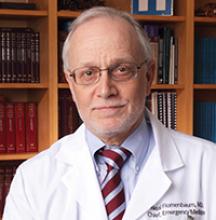John D. States, MD, died on March 26, 2015 in Rochester, New York, where he lived and practiced most of his life. Though he was not an emergency physician (EP), he had a profound effect on the practice of emergency medicine by helping to change the destination of thousands of car crash victims each year from the morgue to the ED.
A chair of orthopedic surgery at Rochester General Hospital and a lifelong automobile enthusiast, Dr States was also the track physician at Watkins Glen International Speedway, where he soon realized that even though the speeds of car crashes on the track were far greater than those on the highways, race-car drivers, protected by seatbelts, helmets, and safety cages or rollbars, typically walked away from their crashes, while drivers and passengers in highway accidents often did not.
Dr States began to research and to document the causes and consequences of severe crashes on his own—even before he began to receive federal funding to establish accident investigation teams. He often interrupted family drives when he came upon a crash site in order to take measurements and obtain information and went on to develop the Abbreviated Injury Scale (AIS) used throughout the world to standardize the measurements of automobile-related trauma injuries. According to the Association for the Advancement of Automotive Medicine, an organization he helped to found and lead, Dr States became an expert in the biomechanics of knee, hip, and spinal injuries, enabling him to develop seatbelt, dashboard, and airbag designs to reduce injuries.
Although Dr States was consulted frequently by auto manufacturers on ways to make cars safer, they did not heed his advice to voluntarily install seatbelts and other safety devices before it became the law. Acting on Dr States’ recommendations, New York State required manufacturers to equip all new cars with seatbelts beginning in 1964 and in 1984 became the first state to mandate their use. Similar laws followed in all but one other state, and John D. States has since been known as “Dr Seatbelt.”
Although mandatory seatbelt usage has been estimated to save 12,000 lives a year, Dr States never suggested that seatbelts alone could prevent all deaths and injuries from automobile crashes. In one of the 83 papers he authored or coauthored, a 1994 Journal of Trauma study (1994;37[3]:404-447) found that the patterns of injury resulting in the deaths of 91 unrestrained and 27 restrained vehicle crash victims were largely the same, with the exception of a 19.8% decrease in injuries resulting from ejection and a lower incidence of cerebral contusions (37% vs 71%) in the restrained group. Head, thoracic, and abdominal injuries followed similar patterns, with cranial injuries being the most likely cause of death in almost two thirds of the victims of both groups. Dr States and his colleagues concluded that accidents involving crushing, intrusion, and significant deceleration exceed the ability of restraints alone to prevent many fatal injuries.
Some of the implications of this data have already resulted in more protective automobile passenger compartments and additional safety features such as side airbags, collapsible steering wheels, and recessed instrumentation.
Along with increasing the numbers of crash victims reaching EDs alive, safety features now incorporated into automobiles based on Dr States’ work have resulted in significant economic benefits to society and to the auto manufacturers who would not voluntarily adopt the safety measures he had advocated. Of the 12,000 lives a year saved, many undoubtedly go on to purchase replacement vehicles and probably continue to purchase new vehicles for many years to come. And, should the next generation of vehicles incorporate sensors and systems to prevent impacts independently of driver-controlled measures, the ideas and principles that John D. States, MD, championed throughout his life may someday reduce ED overcrowding as well.

